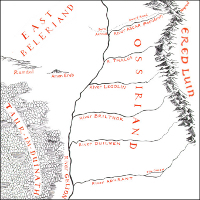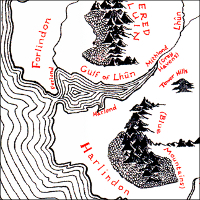Places in Middle-earth
Lindon
Type: Kingdoms, Realms, Lands
Region: Arnor/Eriador/Lindon
Meaning: Land of music
Other Names
First Age only: Ossiriand 'Land of Seven Rivers'
Location: In the First Age, Lindon was Ossiriand, the southeastern region of Beleriand between the River Gelion and the Blue Mountains. After the Sinking of Beleriand, the name referred to the remnant of Ossiriand not sunken into the sea, the realm of Gil-galad.
Description:
In Ossiriand dwelt the Green-elves, in the protection of their rivers.... [The] sound of their singing could be heard even across the waters of Gelion; wherefore the Noldor named that country Lindon, the land of music, and the mountains beyond they named Ered Lindon....
The Silmarillion, Quenta Silmarillion, Ch 14, Of Beleriand and its Realms
[In] the days of the old world of the First Age... the forefathers of the Edain... crossed the Blue Mountains into Beleriand, of which Lindon is all that now remains.
The Lord of the Rings, Appendix A, Annals of the Kings and Rulers: Eriador, Arnor, and the Heirs of Isildur: The North-kingdom and the Dúnedain
In the Great Battle and the tumults of the fall of Thangorodrim there were mighty convulsions in the earth, and Beleriand was broken and laid waste; and northward and westward many lands sank beneath the waters of the Great Sea. In the east, in Ossiriand, the walls of Ered Luin were broken, and a great gap was made in them towards the south, and a gulf of the sea flowed in. Into that gulf the River Lhûn fell by a new course, and it was called therefore the Gulf of Lhûn. That country had of old been named Lindon by the Noldor, and this name it bore thereafter....
The Silmarillion, Of the Rings of Power and the Third Age
But that land where Lúthien had dwelt remained, and was called Lindon.... [In] the land that was left north and south 1 of the gulf the Elves remained....
The Lost Road and Other Writings, HoME Vol 5, Part 1, Ch 2, The Fall of Númenor
[The] Exiles 2 (such few as remained)..., held still to Lindon, the remnant of Beleriand west of the Ered Luin. There Gil-galad was their lord, until the Second Age drew to its end.
The Peoples of Middle-Earth, HoME Vol 12, Part 1, Ch 2, The Appendix on Languages: Commentary
In Lindon Sauron had as yet no dominion.
The Lost Road and Other Writings, HoME Vol 5, Part 1, Ch 2, The Fall of Númenor
Upon the shores of the Gulf of Lhûn the Elves built their havens, and named them Mithlond....
The Silmarillion, Of the Rings of Power and the Third Age
[It] is said that... Elendil... escaping from the fall of Númenor came at last to the mouths of the rivers that flowed into the Western Sea. And Elendil..., came to Lindon and dwelt there a while, and passed into Middle-earth and established a realm in the North.
The Lost Road and Other Writings, HoME Vol 5, Part 1, Ch 2, The Fall of Númenor
At its greatest Arnor included all Eriador, except the regions beyond the Lune, and the lands east of Greyflood and Loudwater.... Beyond the Lune was Elvish country, green and quiet, where no Men went; but Dwarves dwelt, and still dwell, in the east side of the Blue Mountains, especially in those parts south of the Gulf of Lune, where they have mines that are still in use. For this reason they were accustomed to pass east along the Great Road.... At the Grey Havens dwelt Círdan the Shipwright, and some say he dwells there still, until the Last Ship sets sail into the West. In the days of the Kings most of the High Elves that still lingered in Middle-earth dwelt with Círdan or in the seaward lands of Lindon. If any now remain they are few.
The Lord of the Rings, Appendix A, Annals of the Kings and Rulers: Eriador, Arnor, and the Heirs of Isildur
Etymology
lin- This root, meaning 'sing, make a musical sound', occurs in Ainulindalë, Laurelin, Lindar, Lindon, Ered Lindon, lómelindi 3.
The Silmarillion, Appendix: Elements in Quenya and Sindarin Names
Notes
1 The map drawn by Christopher Tolkien in The Lord of the Rings names Forlindon as the part of Lindon north of the Gulf of Lune (Lhûn), and Harlindon as its southern counterpart.
2 Exiles: the Noldor.
3 lómelindi Quenya word meaning 'dusk-singers': nightingales.
The Silmarillion, Index of Names
Contributors:
Lyllyn 4May03, 7Jan05
Elena Tiriel 18Nov09, 16Jul10, 30Dec12



